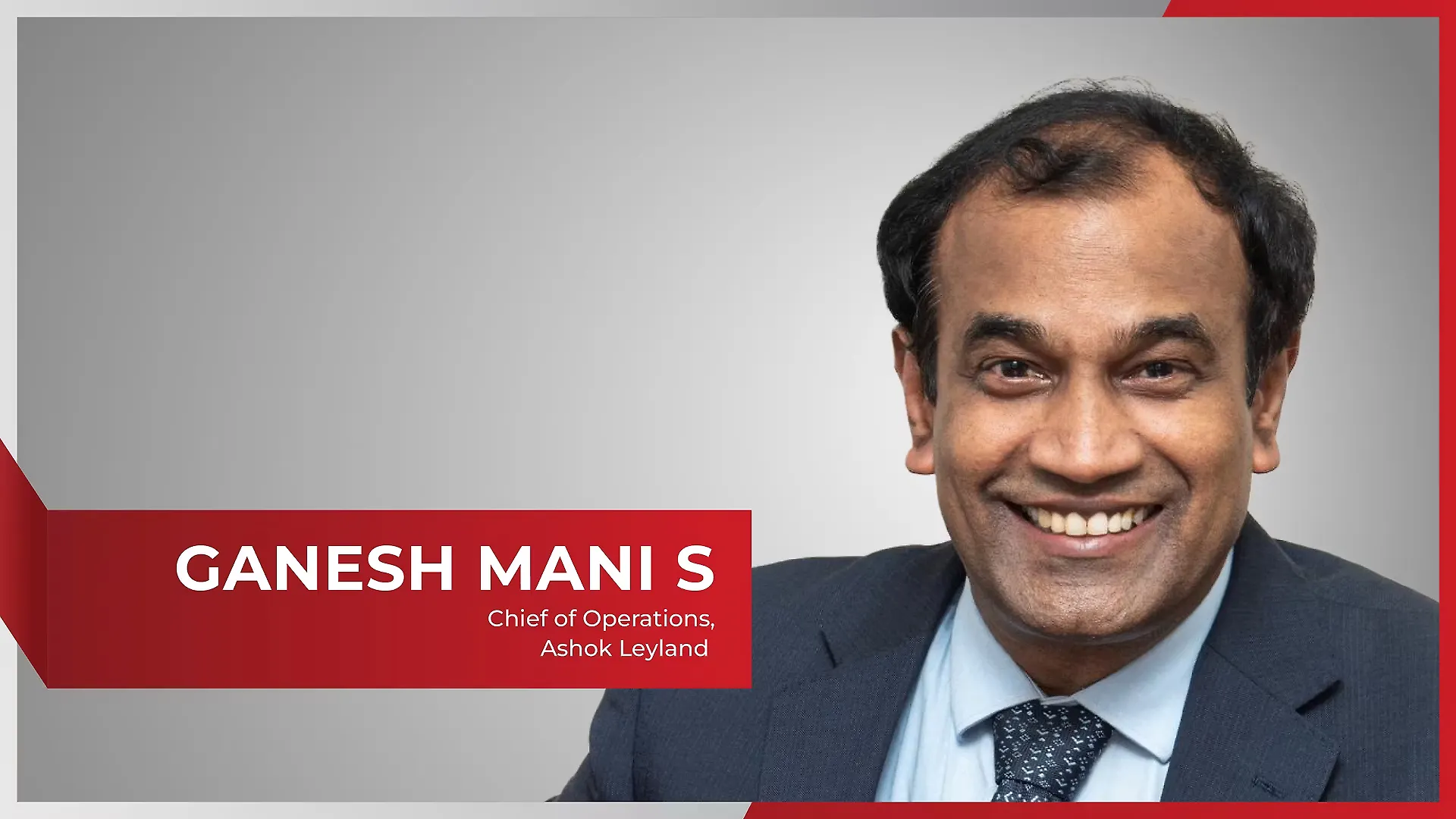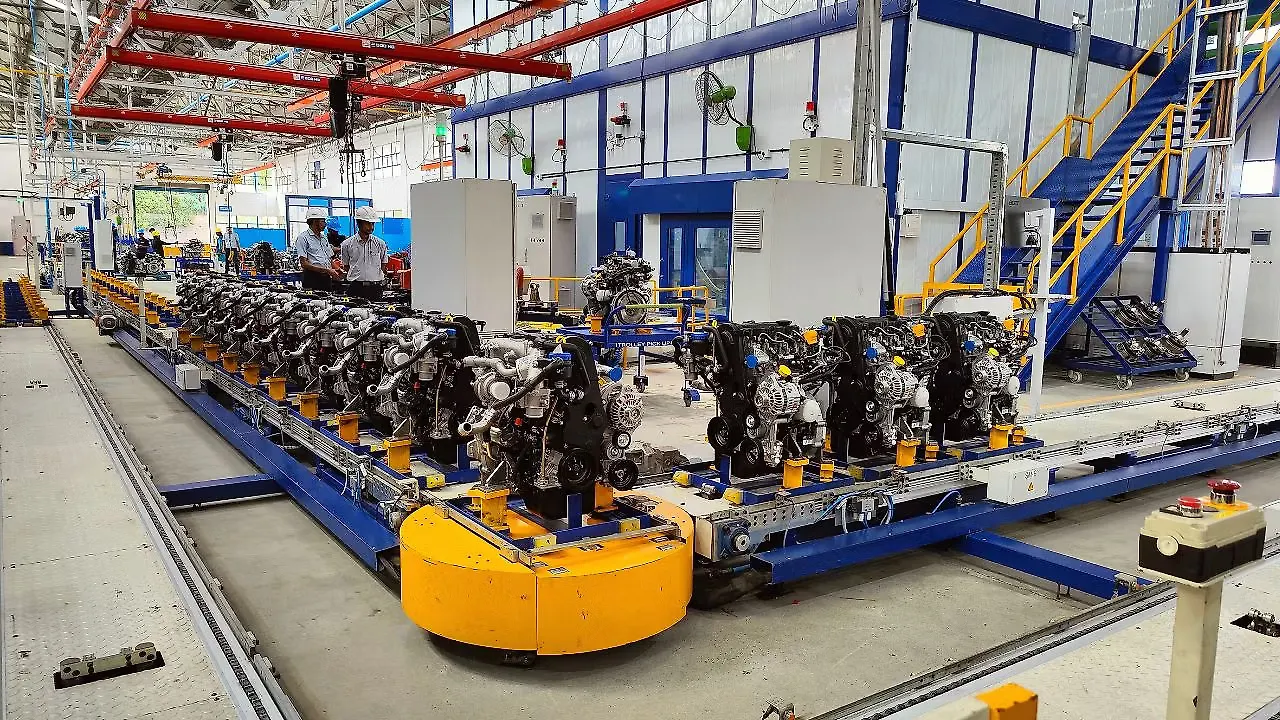
Ganesh Mani S is the Chief of Operations at Ashok Leyland. Earlier, he was Wholetime Director (Operations) at Hyundai Motor India, and had worked as Vice President in Maruti Suzuki India and Bharat Heavy Electricals in the past. He holds MBA from the Management Development Institute, a fellowship from the International Management Institute and a Management degree in Global Executive Programme from the Indian School of Business.
The commercial vehicle (CV) industry is highly volatile, and manufacturing plays a vital role in catering to market requirements and optimisation of resources. How do you mitigate these issues?
The CV industry is very cyclical, and it goes up to 70% minus and 70% plus. We see the problems and solutions in three parts – flexibility in operations, proximity to customers and preparing the people to manage all these challenges.
Can you elaborate?
We have seven manufacturing plants in India, evenly spread in southern and northern regions. We have integrated manufacturing operations for casting, engine and gearbox, and the entire chassis. In addition, we have the AVTR modular platform, which helps in upscaling and downscaling options. AVTR has dual advantages; it gives customers many opportunities in customisation. Besides, it makes back-end operations a little better so that all the activities keep moving ahead.
During the last one year, we have also seen that irrespective of the models that are being planned – be it AVTR or regular models – they are manufactured across regional facilities, making inter-logistic operations as effective as possible.
We have enabled the capabilities of our people, and have therefore been making two to three models in a single line. Our efforts are to further enable these lines with multiple possibilities to optimise manufacturing.
AVTR gives innumerable options to the customers. However, it varies the TAKT time and increases inventory. How do you mitigate these issues?
There is always an in-built answer when the problems and opportunities are worked together. AVTR gave conceptualisation of how far we can make it from a commonality perspective. We began working with our supplier-partners on part commonality in the systems made by them. As customers keep changing their options, we could also manoeuvre this at the back end. It happens for all the models now.

We have been constantly working on programme management and have now improved to 75% in quick conversion of thought process into action and delivery of these products. For example, to VRL, one of our esteemed customers, who wanted a specific model in CNG, we could deliver in a record time of less than three months despite being a completely new product in a new platform. We worked at the back end all-across the functions together.
Quite interesting! To what extent areyou leveraging autonomation?
We have over 150 robots installed in all our factories. Today, we have digitally-enabled and industry 4.0-enabled lines. We have introduced a new concept called MPAS (Manufacturing Process Assurance System) across plants, a common way of making industry 4.0-enabled lines, making the process much easier, while helping the operator function efficiently.
The TAKT times run into about 10 minutes in CV manufacturing; therefore, individual operators need to do multiple jobs on the same line. Unless and otherwise we autonomate these processes, it is very difficult to take care of men and machines. So, we are building all those facilities inside, which helps us be alert if any problem occurs and stop the machine if needed. That is the journey we would like to move on.
Going for IoT and Industry 4.0 will generate a lot of data. Can you tell us about the initiatives taken on these lines?
As part of MPAS, we collect all these data and store them in our own storage for crunching, and will be used as a repository for multiple areas. Getting into Cloud is not new for us as our ‘iALERT’ system, introduced a couple of years ago, collects data every 35 seconds from over 1.5 lakh tucks. These help us understand the vehicle and the customers too. We would like to enhance the utilisation of the data rapidly.
Customers are satisfied only with flawless products. How do you ensure such products are delivered?
In the 75 years of the company’s existence, we have always kept customer satisfaction as the top most agenda. Earlier, it used to be highly people-oriented and skill-oriented staff, and we were managing well. Now utilisation of these technologies is helping us. That is where we wanted to create a great distinction between us and other players in terms of our shopfloor associates. We wanted to train them as data scientists. We will extensively train them to ensure they feel proud of their actions.
You are known for enhancing productivity without major investments. What are your plans now?
CV manufacturing is complex as we make gears, engines, transmissions, chassis and others in-house. We have a hybrid way of combining everything together – the hybrid equivalent of the chassis unit (HECU). We convert every process into these numbers of HECU and calculate how many things are currently required for 100 man-days. These are mapped to calculate the requirements, and the same is converted into making every part. We have a commonality of chassis.
We have a technique called rapid entire body analysis, and our associates use this to understand what changes need to be done on the assembly line to increase or reduce production. We have already built this flexibility, and have a repository of multiple possible options. Like modular platforms, we have modularity in the assembly line of each and every plant that is specific to the kind of models produced.
What kind of initiatives do you plan to introduce in the factories?
We need to consider a couple of things to introduce innovative ideas: how far can the jobs be made easier for the people involved. We now have technologies that can identify issues and understand themselves, which makes the job easier. There are still some jobs wherein people need to work on the vehicles. Unlike the passenger car industry, making commercial vehicles begins with assembling the chassis and tilting it to assemble the rest of the aggregates and build the cabins. That becomes the easy way of manoeuvring it. However, we will also explore additional facilities to make the associates comfortable.

We have just introduced ALSIAT (Ashok Leyland Smart Innovation and Automation Team), giving people exclusive tasks to come out with options by themselves. Some projects are extremely beautiful; they don’t require so much technology. Some of them are being trained in these areas. We would like to take it to the next level of digitisation using these kinds of technologies and techniques to leapfrog when celebrating our 75th anniversary.
How are you leveraging your tech centre to enhance your manufacturing operations?
We have two tech centres – the one in Vellivoyalchavadi helps us in proto-building using digital mark-up for the plant and project planning. People from R&D and quality control help us to quickly bring the product and assemble it at ease.
For the associates and blue collars, we have introduced Nalanda, which teaches them the basic skills of assembling a product, virtually first and then physically, before they move on to the assembly line. The idea is to make people understand what a truck is all about before assembling and also get a lot of simulated exercises. The person who walks away from Nalanda will be a full-fledged associate, who can immediately assemble vehicles.
What is your vision for Ashok Leyland with respect to manufacturing?
Our vision is to be agile and efficient in our operations through innovative technology by creating a happy workplace using sustainable practices. This is most important going forward and across the value chain.
Incidentally, we have set a target of zero at hundred in terms of sustainable practices. We are in our 75th year, and by the time we turn 100, we want to become absolutely zero in terms of carbon emissions and the Scope 1, Scope 2 and Scope 3 concerns. Zero at Hundred is our new slogan.
What kind of excitement are you creating to attract talent in manufacturing, otherwise grabbed by other industries, including IT and software?
We have multiple locations, and there are several engineering colleges around. I tell them they will not be software engineers, but data scientists. This would incentivise them to enter Ashok Leyland rather than enter other industries. Second, they will be engaged in multiple projects attached to senior teams as a part of mentees. At the end of the second year, they know what kind of knowledge they gained and eventually, become propagators in their colleges.
The girls working at the dedicated assembly line for women at our Hosur plant are our brand ambassadors. That is the journey. Incidentally, more than 60% of new graduate engineering trainees are women. This trend will continue in a more diversified and inclusive manner in the future.
Also Read:
Ashok Leyland To House All Future E-MaaS Business Under OHM
Ashok Leyland Brings Women To The Forefront In Manufacturing